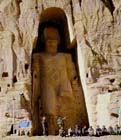Oil was used to paint ancient Buddha murals in Afghanistan
 Washington, April 23 : Experiments performed at the European Synchrotron Radiation Facility (ESRF) have proved that ancient Buddhist paintings from Bamiyan, Afghanistan, were made of oil.
Washington, April 23 : Experiments performed at the European Synchrotron Radiation Facility (ESRF) have proved that ancient Buddhist paintings from Bamiyan, Afghanistan, were made of oil.
These are the same precious paintings from 5th to 9th century A. D. that decorated caves behind the two ancient colossal Buddha statues destroyed by the Taliban.
The discovery attains significance as it suggests that oil had been used in these paintings hundreds of years before the technique was “invented” in Europe in the 15th century.
A study report, appearing in the peer-reviewed Journal of Analytical Atomic Spectrometry, suggests that 12 out of the 50 caves were painted with oil painting technique, using perhaps walnut and poppy seed drying oils.
A combination of synchrotron techniques—such as infrared micro-spectroscopy, micro X-ray fluorescence, micro X-ray absorption spectroscopy or micro X-ray diffraction—was used for the study.
"On one hand, the paintings are arranged as superposition of multiple layers, which can be very thin. The micrometric beam provided by synchrotron sources was hence essential to analyse separately each of these layers. On the other hand, these paintings are made with inorganic pigments mixed in organic binders, so we needed different techniques to get the full picture" said ESRF expert Marine Cotte.
The researchers found a apart from oil-based paint layers, some of the layers were made of natural resins, proteins, gums, and, in some cases, a resinous, varnish-like layer.
“This is the earliest clear example of oil paintings in the world, although drying oils were already used by ancient Romans and Egyptians, but only as medicines and cosmetics,” said Yoko Taniguchi, who led the research team.
The paintings are probably the work of artists who travelled on the Silk Road, the ancient trade route between China, across Central Asia's desert to the West. However, there are very few studies about this region.
“Due to political reasons research on paintings in Central Asia is scarce. We were fortunate to get the opportunity from UNESCO, as a part of conservation project for the World Heritage site Bamiyan, to study these samples and we hope that future research may provide deeper understanding of the painting techniques along the Silk Road and the Eurasian area”, says Taniguchi. (ANI)